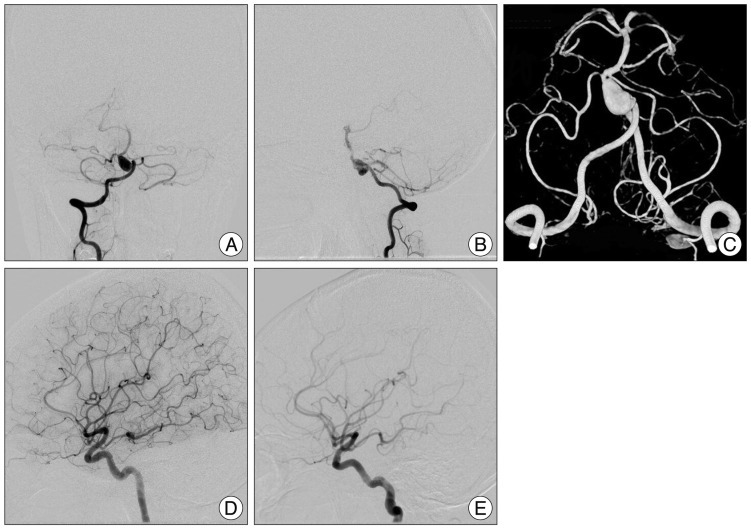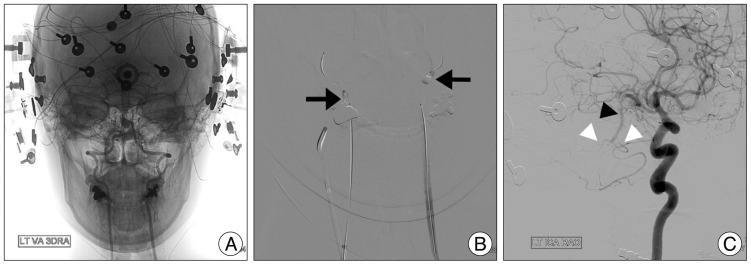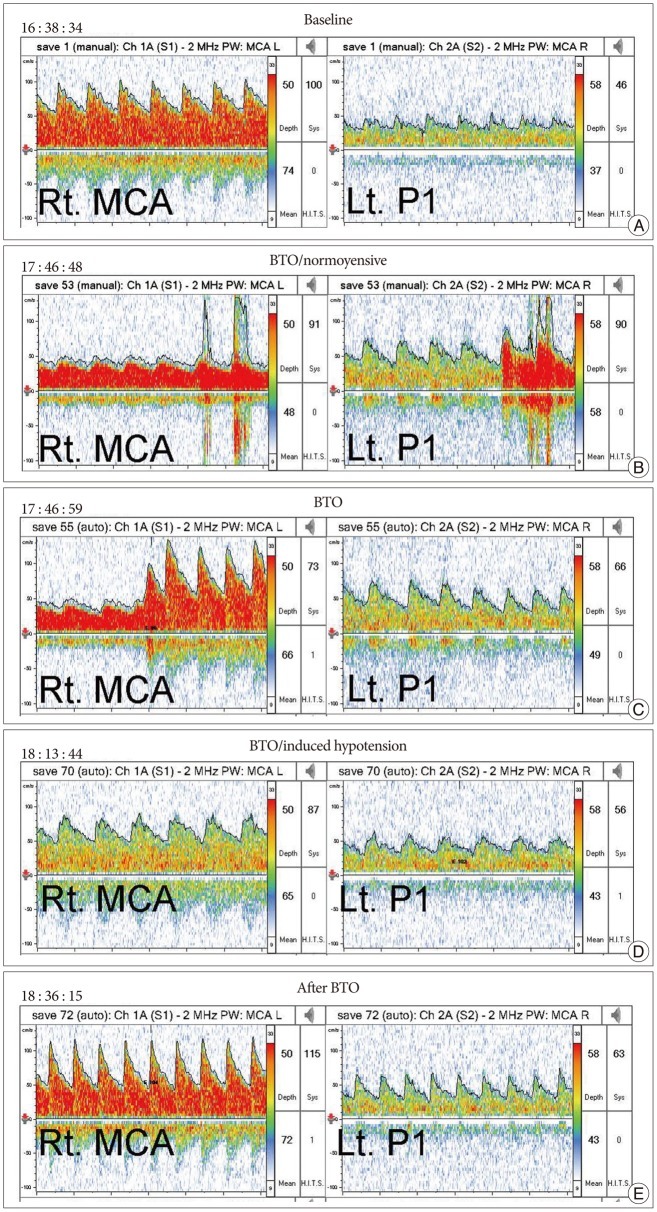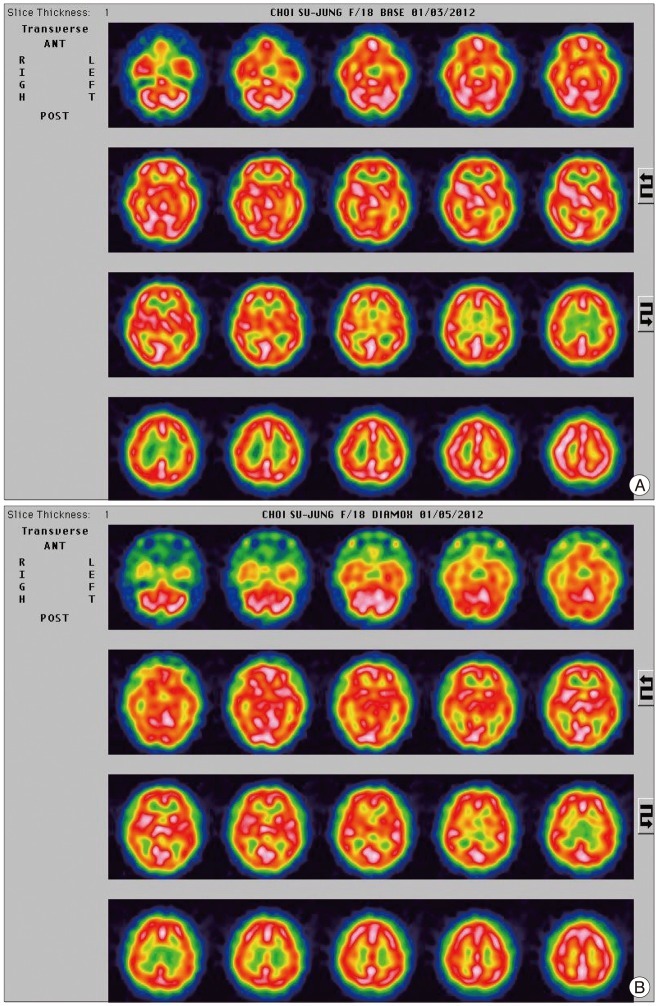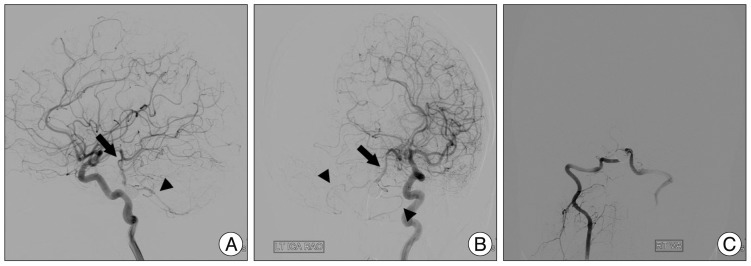J Korean Neurosurg Soc.
2013 Apr;53(4):235-240. 10.3340/jkns.2013.53.4.235.
Fusiform Aneurysm on the Basilar Artery Trunk Treated with Intra-Aneurysmal Embolization with Parent Vessel Occlusion after Complete Preoperative Occlusion Test
- Affiliations
-
- 1Department of Neurosurgery, College of Medicine, Yeungnam University, Daegu, Korea. cch0102@ynu.ac.kr
- KMID: 1426210
- DOI: http://doi.org/10.3340/jkns.2013.53.4.235
Abstract
- Fusiform aneurysms on the basilar artery (BA) trunk are rare. The microsurgical management of these aneurysms is difficult because of their deep location, dense collection of vital cranial nerves, and perforating arteries to the brain stem. Endovascular treatment is relatively easier and safer compared with microsurgical treatment. Selective occlusion of the aneurysmal sac with preservation of the parent artery is the endovascular treatment of choice. But, some cases, particularly giant or fusiform aneurysms, are unsuitable for selective sac occlusion. Therefore, endovascular coiling of the aneurysm with parent vessel occlusion is an alternative treatment option. In this situation, it is important to determine whether a patient can tolerate parent vessel occlusion without developing neurological deficits. We report a rare case of fusiform aneurysms in the BA trunk. An 18-year-old female suffered a headache for 2 weeks. Computed tomography and magnetic resonance image revealed a fusiform aneurysm of the lower basilar artery trunk. Digital subtraction angiography revealed a 7.1x11.0 mm-sized fusiform aneurysm located between vertebrovasilar junction and the anterior inferior cerebellar arteries. We had good clinical result using endovascular coiling of unruptured fusiform aneurysm on the lower BA trunk with parent vessel occlusion after confirming the tolerance of the patient by balloon test occlusion with induced hypotension and accompanied by neurophysiologic monitoring, transcranial Doppler and single photon emission computed tomography. In this study, we discuss the importance of preoperative meticulous studies for avoidance of delayed neurological deficit in the patient with fusiform aneurysm on lower basilar trunk.
Keyword
MeSH Terms
Figure
Reference
-
1. Aymard A, Gobin YP, Hodes JE, Bien S, Rüfenacht D, Reizine D, et al. Endovascular occlusion of vertebral arteries in the treatment of unclippable vertebrobasilar aneurysms. J Neurosurg. 1991; 74:393–398. PMID: 1993904.
Article2. Boardman P, Byrne JV. Giant fusiform basilar artery aneurysm : endovascular treatment by flow reversal in the basilar artery. Br J Radiol. 1998; 71:332–335. PMID: 9616247.
Article3. Cloughesy TF, Nuwer MR, Hoch D, Vinuela F, Duckwiler G, Martin N. Monitoring carotid test occlusions with continuous EEG and clinical examination. J Clin Neurophysiol. 1993; 10:363–369. PMID: 8408601.
Article4. Drake CG, Peerless SJ. Giant fusiform intracranial aneurysms : review of 120 patients treated surgically from 1965 to 1992. J Neurosurg. 1997; 87:141–162. PMID: 9254076.
Article5. Eckert B, Thie A, Carvajal M, Groden C, Zeumer H. Predicting hemodynamic ischemia by transcranial Doppler monitoring during therapeutic balloon occlusion of the internal carotid artery. AJNR Am J Neuroradiol. 1998; 19:577–582. PMID: 9541322.6. Hassan T, Ezura M, Takahashi A. Treatment of giant fusiform aneurysms of the basilar trunk with intra-aneurysmal and basilar artery coil embolization. Surg Neurol. 2004; 62:455–462. discussion 462. PMID: 15518857.
Article7. Higa T, Ujiie H, Kato K, Kamiyama H, Hori T. Basilar artery trunk saccular aneurysms : morphological characteristics and management. Neurosurg Rev. 2009; 32:181–191. discussion 191. PMID: 18791752.
Article8. Higashida RT, Halbach VV, Cahan LD, Hieshima GB, Konishi Y. Detachable balloon embolization therapy of posterior circulation intracranial aneurysms. J Neurosurg. 1989; 71:512–519. PMID: 2795171.
Article9. Lawton MT, Daspit CP, Spetzler RF. Technical aspects and recent trends in the management of large and giant midbasilar artery aneurysms. Neurosurgery. 1997; 41:513–520. discussion 520-521. PMID: 9310966.
Article10. Lesley WS, Bieneman BK, Dalsania HJ. Selective use of the paraophthalmic balloon test occlusion (BTO) to identify a false-negative subset of the cervical carotid BTO. Minim Invasive Neurosurg. 2006; 49:34–36. PMID: 16547880.
Article11. Linskey ME, Jungreis CA, Yonas H, Hirsch WL Jr, Sekhar LN, Horton JA, et al. Stroke risk after abrupt internal carotid artery sacrifice : accuracy of preoperative assessment with balloon test occlusion and stable xenon-enhanced CT. AJNR Am J Neuroradiol. 1994; 15:829–843. PMID: 8059649.12. Marshall RS, Lazar RM, Mohr JP, Pile-Spellman J, Hacein-Bey L, Duong DH, et al. Higher cerebral function and hemispheric blood flow during awake carotid artery balloon test occlusions. J Neurol Neurosurg Psychiatry. 1999; 66:734–738. PMID: 10329746.
Article13. Matsuda H, Yagishita A, Tsuji S, Hisada K. A quantitative approach to technetium-99m ethyl cysteinate dimer : a comparison with technetium-99m hexamethylpropylene amine oxime. Eur J Nucl Med. 1995; 22:633–637. PMID: 7498224.
Article14. Michael WF. Posterior fossa aneurysms simulating tumours. J Neurol Neurosurg Psychiatry. 1974; 37:218–223. PMID: 4819910.
Article15. Omahen DA, Findlay JM. A giant fusiform basilar aneurysm treated by bilateral vertebral artery occlusion. J Clin Neurosci. 2004; 11:324–328. PMID: 14975432.
Article16. Pelz DM, Viñuela F, Fox AJ, Drake CG. Vertebrobasilar occlusion therapy of giant aneurysms. Significance of angiographic morphology of the posterior communicating arteries. J Neurosurg. 1984; 60:560–565. PMID: 6699698.17. Pia HW. Classification of vertebro-basilar aneurysms. Acta Neurochir (Wien). 1979; 47:3–30. PMID: 474201.
Article18. Sorteberg A, Bakke SJ, Boysen M, Sorteberg W. Angiographic balloon test occlusion and therapeutic sacrifice of major arteries to the brain. Neurosurgery. 2008; 63:651–660. dicussion 660-661. PMID: 18824944.
Article19. Standard SC, Ahuja A, Guterman LR, Chavis TD, Gibbons KJ, Barth AP, et al. Balloon test occlusion of the internal carotid artery with hypotensive challenge. AJNR Am J Neuroradiol. 1995; 16:1453–1458. PMID: 7484632.20. Steinberg GK, Drake CG, Peerless SJ. Deliberate basilar or vertebral artery occlusion in the treatment of intracranial aneurysms. Immediate results and long-term outcome in 201 patients. J Neurosurg. 1993; 79:161–173. PMID: 8331396.
Article21. Su CC, Watanabe T, Yoshimoto T, Ogawa A, Ichige A. Proximal clipping of dissecting intracranial vertebral aneurysm--effect of balloon Matas test with neurophysiological monitoring. Case report. Acta Neurochir (Wien). 1990; 104:59–63. PMID: 2386090.
Article22. Tomura N, Omachi K, Takahashi S, Sakuma I, Otani T, Watarai J, et al. Comparison of technetium Tc 99m hexamethylpropyleneamine oxime single-photon emission tomograph with stump pressure during the balloon occlusion test of the internal carotid artery. AJNR Am J Neuroradiol. 2005; 26:1937–1942. PMID: 16155138.23. Uda K, Murayama Y, Gobin YP, Duckwiler GR, Viñuela F. Endovascular treatment of basilar artery trunk aneurysms with Guglielmi detachable coils : clinical experience with 41 aneurysms in 39 patients. J Neurosurg. 2001; 95:624–632. PMID: 11596957.
Article24. Van Rooij WJ, Sluzewski M, Menovsky T, Wijnalda D. Coiling of saccular basilar trunk aneurysms. Neuroradiology. 2003; 45:19–21. PMID: 12525949.
Article
- Full Text Links
- Actions
-
Cited
- CITED
-
- Close
- Share
- Similar articles
-
- Giant fusiform aneurysm at the basilar trunk treated with endovascular coil occlusion following bypass surgery for the flow diversion
- Dual Stent-Assisted Coil Embolization for Fusiform Aneurysm Arising From Persistent Trigeminal Artery
- Treatment of a Sequential Giant Fusiform Aneurysm of the Basilar Trunk
- Endovascular Treatment of Giant Basilar Trunk Aneurysm: Case Report
- Giant Vertebrobasilar Junction Aneurysm Treated with Proximal Occlusion of Parent Artery Followed by Coil Embolization of Partially Thrombosed Aneurysm: A Case Report

